The Wound Evacuators Market is estimated to be valued at USD 432.4 million in 2025 and is projected to reach USD 646.2 million by 2035, registering a compound annual growth rate (CAGR) of 4.1% over the forecast period.
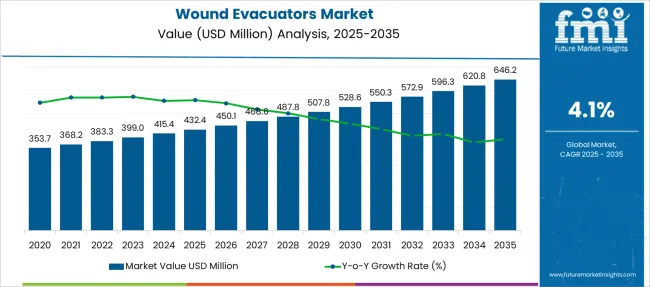
| Metric | Value |
|---|---|
| Wound Evacuators Market Estimated Value in (2025 E) | USD 432.4 million |
| Wound Evacuators Market Forecast Value in (2035 F) | USD 646.2 million |
| Forecast CAGR (2025 to 2035) | 4.1% |
The wound evacuators market is growing steadily, driven by the increasing focus on advanced wound care and management, especially for chronic wounds that require prolonged treatment. Medical professionals have highlighted the importance of efficient wound fluid removal in promoting faster healing and preventing infections.
The rising prevalence of chronic conditions such as diabetes and vascular diseases has contributed to a growing patient population needing specialized wound management solutions. Innovations in wound care technologies and increasing adoption of negative pressure wound therapy have enhanced the use of wound evacuators.
Healthcare facilities, particularly hospitals, are investing in effective wound management devices to improve patient outcomes and reduce hospital stays. Future growth is expected to be fueled by expanding hospital infrastructure and increased awareness of wound care best practices. Segmental growth is anticipated to be led by Closed Systems in product type, Chronic Wounds as the primary wound type, and Hospitals as the dominant end user.
The market is segmented by Product Type, Wound Type, and End User and region. By Product Type, the market is divided into Closed Systems and Open Systems. In terms of Wound Type, the market is classified into Chronic Wounds, Pressure Ulcers, Diabetes Foot Ulcers, Venous Ulcers, Acute Wounds, and Others. Based on End User, the market is segmented into Hospitals, Clinics, and Others. Regionally, the market is classified into North America, Latin America, Western Europe, Eastern Europe, Balkan & Baltic Countries, Russia & Belarus, Central Asia, East Asia, South Asia & Pacific, and the Middle East & Africa.
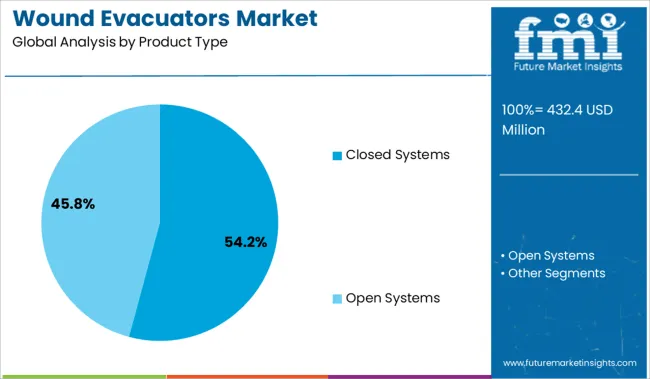
The Closed Systems segment is expected to account for 54.2% of the wound evacuators market revenue in 2025, holding its position as the leading product type. This segment has gained prominence due to its ability to provide a sterile and sealed environment that effectively collects wound exudate while minimizing infection risks.
Closed systems are favored in clinical settings for their ease of use and reduced contamination potential. Their compatibility with advanced wound therapies and portability has further driven adoption in hospitals and specialized care units.
As infection control remains a high priority in wound management, closed systems are expected to maintain dominance in the market.
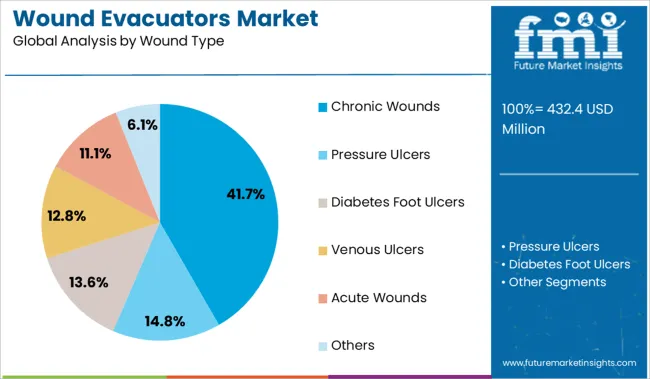
The Chronic Wounds segment is projected to contribute 41.7% of the wound evacuators market revenue in 2025, establishing itself as the leading wound type category. Chronic wounds, including diabetic ulcers and pressure sores, require continuous and effective management to prevent complications.
The long healing time and susceptibility to infection in these wounds have increased demand for reliable wound fluid removal systems. Healthcare providers emphasize the use of advanced wound care devices to improve healing rates and patient quality of life.
The segment benefits from growing awareness of chronic wound prevalence due to aging populations and lifestyle diseases. The focus on minimizing hospital readmissions and improving outpatient care also supports the growth of this segment.
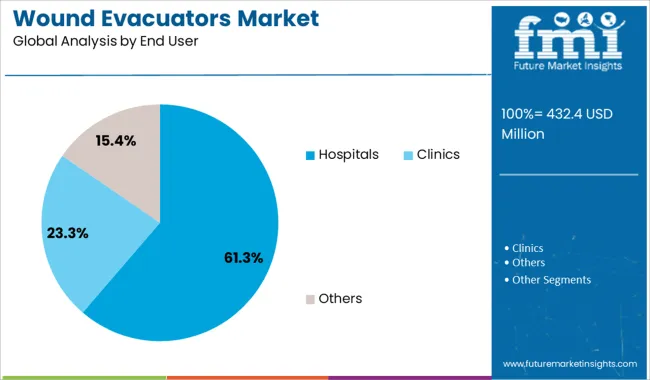
The Hospitals segment is projected to hold 61.3% of the wound evacuators market revenue in 2025, retaining its leadership as the primary end user. Hospitals are the frontline providers of complex wound care treatments and have increasingly adopted wound evacuators as part of comprehensive wound management protocols.
The availability of specialized wound care units and trained healthcare professionals facilitates the widespread use of advanced wound evacuation technologies. Additionally, hospitals benefit from improved patient outcomes, shorter hospital stays, and reduced infection rates through effective wound fluid management.
Increasing investments in healthcare infrastructure and emphasis on quality care standards are expected to sustain hospital dominance in this market.
As per FMI, the global demand for wound evacuators is projected to increase at a CAGR of 4.1% between 2025 and 2035, in comparison to the 3% CAGR registered from 2020 to 2024. Growth in the global wound evacuators market is mainly driven by the rising incidence of acute and chronic wounds, increasing healthcare spending, and the growing need for better wound care to reduce complications.
Wound evacuators have become ideal solutions for better wound management used across healthcare facilities. These medical devices allow healthcare professionals to remove infection and facilitate wound healing.
The rising prevalence of chronic wounds such as diabetic foot ulcers, pressure ulcers, and venous ulcers is a key factor pushing the demand for wound evacuators across the world. As per the International Diabetes Federation (IDF), diabetic foot and lower limb complications affect around 40 to 60 million people with diabetes globally. This rise in the number of diabetic foot ulcers will therefore continue to boost the wound evacuators market growth during the forecast period.
Similarly, rising preference for cost-effective wound treatment and advancements in wound evacuators will create lucrative opportunities for wound evacuator manufacturers in the coming years.
The growing adoption of wound evacuators in homecare settings to minimize the risk of infections and reduce healthcare costs is projected to expand the global wound evacuators market size in the future.
Despite a positive growth trajectory, the global wound evacuators market is facing various challenges that are restraining its growth to some extent. Some of these factors are higher prices of wound evacuators, scarcity of trained professionals, and increasing usage of traditional wound management across lower economies.
As per FMI, North America will continue to dominate the global wound evacuators market, accounting for the largest share of 33.9% in 2025. Demand in the North American wound evacuators market is driven by the rising prevalence of chronic diseases, the highly established healthcare industry, increasing spending on wound care, and the heavy presence of leading wound evacuator manufacturers.
Demand for wound evacuators is particularly high across the USA owing to a surge in cases of pressure ulcers and their (pressure ulcers) high morbidity and mortality rates. According to the Agency for Healthcare Research and Quality (AHRQ), over 2.5 million people in the United States develop pressure ulcers each year. This is acting as a catalyst for the growth of the wound evacuators market in the country.
Similarly, rising healthcare spending, an increasing number of hospitals, clinics, and ambulatory centers, and the presence of some of the world’s leading medical device companies are positively impacting the market growth in the region.
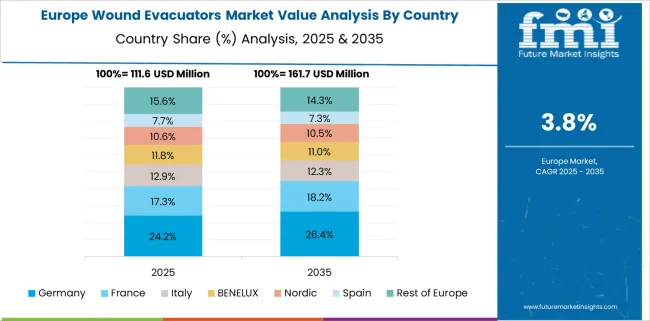
In Europe, the market for wound evacuators is growing significantly owing to the high levels of health awareness among people, the surging burden of chronic wounds, booming medical tourism, favorable government support, and increasing usage of wound evacuators in chronic wound management. According to FMI, Europe holds a share of 27.4% of the global wound evacuators market and this number is likely to further improve during the forecast period.
Within Europe, the United Kingdom and Germany are emerging as the most lucrative markets for wound evacuators due to the increasing incidence of chronic wounds and rising spending on wound care. For instance, as per GOV.UK, there are over 2.2 million people with chronic wounds in the country. Similarly, as per a report published in the Journal of the European Wound Management Association (EWMA Journal), around 0.24% of the population in Germany is affected by chronic wounds. Driven by this, sales of wound evacuators are projected to grow at a considerable pace in the region during the forthcoming years.
Over the years, the field of wound care has witnessed huge developments and advancements from traditional wound management methods to novel ones like negative pressure wound therapy. This has raised interest among various companies to try their hands at manufacturing wound care therapeutics and devices. As a result, there has been a sharp rise in the number of wound-care start-ups that offer a variety of wound management devices like wound evacuators. For instance,
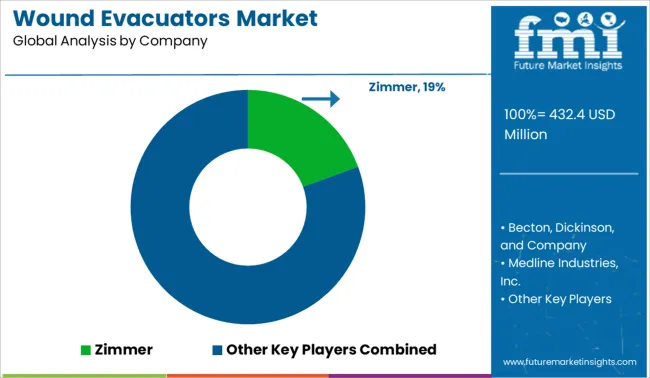
Some of the key wound evacuator manufacturers include Zimmer, Medline Industries, Inc., C. R. Bard, Inc., Redax, Aspen Surgical (sub. Hill-Rom Company), Argon Medical Devices, Inc., and Plasti-med Medikal Ürünler San. Tic. Ltd. among others. These leading players are continuously adopting strategies such as new product launches, mergers, acquisitions, collaborations, and mergers to gain a competitive edge in the global wound evacuators market.
| Report Attribute | Details |
|---|---|
| Growth Rate | CAGR of 4.1% from 2025 to 2035 |
| Market Value in 2025 | USD 383.3 Million |
| Market Value in 2035 | USD 593.6 Million |
| Base Year for Estimation | 2024 |
| Forecast Period | 2025 to 2035 |
| Quantitative Units | Revenue in USD Million and CAGR from 2025 to 2035 |
| Report Coverage | Revenue Forecast, Company Ranking, Competitive Landscape, Growth Factors, Trends, and Pricing Analysis |
| Segments Covered | Product Type, Wound Type, End User, Region |
| Regions Covered | North America; Latin America; Europe; Asia Pacific; Middle East and Africa |
| Key Countries Profiled | United States of America, Canada, Brazil, Mexico, Germany, United Kingdom, France, Spain, Italy, China, Japan, South Korea, Malaysia, Singapore, Australia, GCC Countries, South Africa, Israel |
| Key Companies Profiled | Zimmer; Medline Industries, Inc.; C. R. Bard, Inc.; Redax; Aspen Surgical (sub. Hill-Rom Company); Argon Medical Devices, Inc.; Plasti-med Medikal Ürünler San. Tic. Ltd. |
| Customization | Available Upon Request |
The global wound evacuators market is estimated to be valued at USD 432.4 million in 2025.
The market size for the wound evacuators market is projected to reach USD 646.2 million by 2035.
The wound evacuators market is expected to grow at a 4.1% CAGR between 2025 and 2035.
The key product types in wound evacuators market are closed systems and open systems.
In terms of wound type, chronic wounds segment to command 41.7% share in the wound evacuators market in 2025.






Full Research Suite comprises of:
Market outlook & trends analysis
Interviews & case studies
Strategic recommendations
Vendor profiles & capabilities analysis
5-year forecasts
8 regions and 60+ country-level data splits
Market segment data splits
12 months of continuous data updates
DELIVERED AS:
PDF EXCEL ONLINE
Wound Wash Market Size and Share Forecast Outlook 2025 to 2035
Wound Type Current Transformer Market Size and Share Forecast Outlook 2025 to 2035
Wound Skin Care Market - Demand & Forecast 2025 to 2035
Wound Care Surfactant Market Insights – Demand and Growth Forecast 2025 to 2035
Wound Stimulation Therapy Market Insights – Demand and Growth Forecast 2025 to 2035
Analysis and Growth Projections for Wound Healing Nutrition Market
Wound Irrigation Systems Market Growth - Trends & Forecast 2025 to 2035
Wound Debridement Products Market Analysis - Growth & Forecast 2025 to 2035
Global Wound Filler Market Analysis – Size, Share & Forecast 2024-2034
Wound Measurement Devices Market
Wound Irrigation Devices Market
Wirewound Resistor Market Size and Share Forecast Outlook 2025 to 2035
Dental Wounds Treatment Market Size and Share Forecast Outlook 2025 to 2035
Animal Wound Care Market Size and Share Forecast Outlook 2025 to 2035
Spiral Wound Membrane Market
The Chronic Wound Care Market is segmented by product, wound type and distribution channel from 2025 to 2035
Topical Wound Agents Market Analysis - Trends, Growth & Forecast 2025 to 2035
Digital Wound Measurement Devices Market is segmented by Diabetic Ulcer, Chronic Wounds, Burns from 2025 to 2035
Advance Wound Care Market Analysis by Advance Wound Dressings, NPWT Devices and Others through 2035
Surgical Wound Care Market Size and Share Forecast Outlook 2025 to 2035

Thank you!
You will receive an email from our Business Development Manager. Please be sure to check your SPAM/JUNK folder too.
Chat With
MaRIA